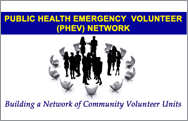|
Emergency Preparedness and Response
|
Emergency Preparedness and
Response Division
Los Angeles County
Department of Public Health
600 S. Commonwealth Ave., Suite 700
Los Angeles, CA 90005
(213) 637-3600
(213) 381-0006 FAX
Public Callers who would like to reach the Emergency Preparedness and Response
Division or a report a public health issue may also call 2-1-1 anytime.

|

Adobe Reader
Note: PDF documents on this site were created using Adobe Acrobat 5.0 or later. If you are using an earlier version of Adobe Acrobat Reader (4.x or less), document functionality may be reduced.
Please
Click Here
|
|
|
CREATING A PERSONAL SUPPORT NETWORK |
If you are
a person with a disability, a personal support network can
help you prepare for a disaster by helping you
- Identify and get the resources you need to cope effectively
with a disaster.
- Practice vital activities like evacuating your home
or workplace.
- Assist you after a disaster happens.
General guidelines for creating
a personal support network:
- You should put together your network before you assess
what your needs will be during and after a disaster.
- Organize a network for your home, school, workplace,
volunteer site, and any other place where you spend a
lot of time. Do not depend on only one person. Include
a minimum of 3 people in your network for each location
where you regularly spend a lot of time during the week.
- Think about what your needs would be during a disaster
and discuss these with each of your networks. Complete
a written assessment of your needs with our network to
help your network members learn the best ways to assist
you and offer additional ideas for you to think about.
- Give your network members copies of your emergency information
list, medical information list, disability-related supplies
and special equipment list, evacuation plan and relevant
documents, and personal disaster plan when you complete
them.
- Arrange with your network to check on you immediately
if local officials give an evacuation order or if a disaster
occurs. Ask your network to notify you of an emergency
you may not know about. For example, if a siren or loudspeaker
system notifies a neighborhood of a disaster and you are
deaf or have hearing loss, be sure that your network knows
to give you this information.
- Arrange on how you and your network will contact each
other during an emergency. Do not count on telephones
working. Also, choose a signal for help that you both
understand. Signals can be shouting, knocking on the wall,
or using a whistle, bell, or high-pitched noisemaker.
Visual signals could include hanging a sheet outside your
window.
- Give the members of your network all the necessary keys
they may need to get into your home, car, etc.
- Show your network how to operate and safely move the
equipment you use for your disability.
- Make sure your service animal knows the people in your
network. This will make it easier for the animal to accept
care from someone other than yourself.
- Explain to your network any assistance for personal
care that you may need. Give them written instructions
on how best to assist you and your animals.
- Label your equipment and attach laminated instruction
cards on how to use and move each item.
- Inform your network about any areas on your body where
you have reduced feeling so they can check these areas
for injuries after a disaster if you cannot check them
yourself.
- Practice your plan.
- Choose an emergency meeting place for each area where
you spend a lot of time that you are familiar with where
you and others can reunite after exiting a building.
- Select with your network a signal that you can use to
let them know you are okay and have left their site.
- Give your network your travel dates if you will be traveling.
- Review and revise with your network your disaster plan
regularly, or as your condition changes.
|
|
Our Vision: Los Angeles County residents are protected from the public health consequences of both natural
and intentional emergencies.
Our Mission: To prevent and mitigate the public health consequences of natural or intentional emergencies for Los
Angeles County residents through threat assessment, planning, improved operational readiness, and timely response.
|
 Southern California has about 10,000 earthquakes each year, though most are so small that they are never felt. (readyla.org)
Smoke alarms should be tested every month, and batteries replaced at least once a year. (redcross.org)
During hot weather, people should drink more liquid than their thirst indicates, up to four 16-ounce glasses per hour if exercising in the heat. (readyla.org)
Cooking is the major cause of home fires in the U.S. (readyla.org)
Space heaters are a common cause of fires during winter and should be kept at least three feet from drapes and furniture. (readyla.org)
The most common home chemical emergencies involve small children eating medicines. Experts say that taking hazardous materials out of sight could eliminate up to 75% of all poisoning of small children. (redcross.org)
There is no such thing as “earthquake weather.” Earthquakes can occur in any type of weather. (readyla.org)
The most common illnesses treated in the U.S. include colds and coughs, flu, sore throat, bladder infection, and more seriously, cancer, heart disease, and stroke. (readyla.org)
Each year, fire kills more Americans than all other natural disasters combined. (readyla.org)
During an earthquake, get under a sturdy piece of furniture and hold on. This will provide some protection from falling objects that can injure you. Doorways are no stronger than any part of the structure. (redcross.org)
65% of home fire deaths occur in homes with no working smoke alarms. (redcross.org)
The San Andreas Fault is not a single, continuous fault, but rather a fault zone consisting of many different segments. Its fault system is more than 800 miles long. (readyla.org)
City dwellers may be at greater risk than those in rural areas during heat waves because asphalt and concrete store heat longer and gradually release it at night. (readyla.org)
Los Angeles County utilizes a Terrorism Early Warning group to constantly assess terrorist attacks and keep authorities and the public updated. (readyla.org)
Southern California has about 10,000 earthquakes each year, though most are so small that they are never felt. (readyla.org)
Smoke alarms should be tested every month, and batteries replaced at least once a year. (redcross.org)
During hot weather, people should drink more liquid than their thirst indicates, up to four 16-ounce glasses per hour if exercising in the heat. (readyla.org)
Cooking is the major cause of home fires in the U.S. (readyla.org)
Space heaters are a common cause of fires during winter and should be kept at least three feet from drapes and furniture. (readyla.org)
The most common home chemical emergencies involve small children eating medicines. Experts say that taking hazardous materials out of sight could eliminate up to 75% of all poisoning of small children. (redcross.org)
There is no such thing as “earthquake weather.” Earthquakes can occur in any type of weather. (readyla.org)
The most common illnesses treated in the U.S. include colds and coughs, flu, sore throat, bladder infection, and more seriously, cancer, heart disease, and stroke. (readyla.org)
Each year, fire kills more Americans than all other natural disasters combined. (readyla.org)
During an earthquake, get under a sturdy piece of furniture and hold on. This will provide some protection from falling objects that can injure you. Doorways are no stronger than any part of the structure. (redcross.org)
65% of home fire deaths occur in homes with no working smoke alarms. (redcross.org)
The San Andreas Fault is not a single, continuous fault, but rather a fault zone consisting of many different segments. Its fault system is more than 800 miles long. (readyla.org)
City dwellers may be at greater risk than those in rural areas during heat waves because asphalt and concrete store heat longer and gradually release it at night. (readyla.org)
Los Angeles County utilizes a Terrorism Early Warning group to constantly assess terrorist attacks and keep authorities and the public updated. (readyla.org)
|
|
|
|

 VOLUNTEER OPPORTUNITIES
VOLUNTEER OPPORTUNITIES


